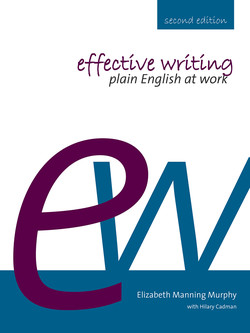Читать книгу Effective Writing - Elizabeth Manning Murphy - Страница 4
На сайте Литреса книга снята с продажи.
Preface
ОглавлениеSince the first edition of this book (known to me as EW1) appeared twenty-five years ago, there have been significant changes in the ways in which we write to each other. Gone are some of the older documents we were familiar with, replaced by new documents, many computer based. We now make regular use of email, the web and social media; our language more consciously reflects social attitudes. Many more of us are working from home, using various means – computers, tablets, smart phones, Skype and so on – to make the home office workable. These factors influence the effectiveness of our workplace writing.
The aims of the book have not changed – to provide the tools needed for:
improving writing skills in a multi-skilled work environment
understanding how to make writing easily understood
getting rid of gobbledegook in all official writing.
We still need the foundation of acceptable grammar, good sentence structure and plain English to get our message across to a target audience, just as we did all those years ago. In addition, we now need to consider how to make emails as effective as paper-based correspondence. We need to adjust our language to keep up with social changes, and to be aware that technology is changing rapidly.
This updated edition continues to be a useful resource for all workplace writers, and for those teaching or training in workplace writing. There is new material throughout that refers to writing using electronic media. This edition is written in a style that reflects current stylistic guidelines for authors and editors in Australia – a style that is comparable to those used in other English-speaking communities.
I refer to my recent publication Working words (pub. Canberra Society of Editors <http://www.editorscanberra.org>, 2011) in this book. Working words is a collection of ‘chats’ about aspects of writing: English grammar, editing, working from home and the ethics of editing. It is a companion to more formal books on these subjects. In it, I noted that I am not a prescriptive grammarian but a descriptive linguist. That applies equally to this book. Making our workplace words work means sticking to some writing conventions but also moving with the times – English is a living, changing language. For spelling, I have followed the recommendations of the Macquarie Dictionary, an Australian English reference. I acknowledge that there are other spelling conventions in the English-speaking world, and these are outlined in Chapter 3 (Spelling). There are also textual references to other texts and websites, as necessary and as relevant at the time of writing.
Heartfelt thanks are due to my friend and colleague Hilary Cadman MSc PhD ELS AE (IPEd) for revising, restructuring and updating this book with me, for formatting help, and generally for being there for advice and guidance on writing within newer technologies. Thanks also to Shelagh Snell FESB MISM for help in reviewing the text for international relevance; and to Linda Nix, for managing production and publication; Carina Manning for cover design; Ted Briggs AE (IPEd) for cover photo; and Joanne Williams and Louise M Oliver for copyediting. Acknowledgment is also due to Pearson Australia, Melbourne, successors to the original publishers, Pitman, for reverting copyright to me. This enabled me to publish this completely revised and updated edition of Effective writing: plain English at work (first published 1989 in Australia). This book (EW2 to me), like its predecessor, is dedicated to everyone who wants to write effectively.
Elizabeth Manning Murphy
JP BA Hons (Linguistics)
FCES FSBT (UK) AFAIM DE (IPEd)
Canberra, 2014
